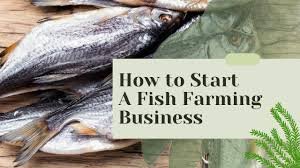
Fish farming, also known as aquaculture, is one of the fastest-growing sectors in the global food industry. With an increasing demand for fish as a source of protein, sustainable fish farming presents a lucrative business opportunity for entrepreneurs. Whether you’re looking to start small or scale into commercial production, understanding the right methods, equipment, and management techniques is key to success.
Fish farming is not only profitable but also helps reduce pressure on wild fish populations, promoting environmental conservation. Many governments and private investors are supporting aquaculture to meet the world’s growing food needs. This blog article will walk you through everything you need to know about starting a successful fish farming business, from selecting the right species to maintaining water quality and managing your fish stock.
What is Fish Farming?
Fish farming involves breeding and raising fish in controlled environments such as ponds, tanks, or cages. It can be done on a small scale for local consumption or on a large scale for commercial purposes. Some of the most commonly farmed fish include tilapia, catfish, salmon, and trout.
Why Fish Farming?
High Demand: With a growing population and increasing awareness of healthy diets, fish is a staple food worldwide.
Profitability: With proper management, fish farming can yield high returns.
Sustainability: Unlike wild fishing, aquaculture helps preserve natural fish populations.
Flexibility: Can be practiced in rural and urban areas, using ponds, tanks, or recirculating systems.
Job Creation: Fish farming provides employment opportunities in production, processing, and distribution.
Choosing the Right Fish Species
Selecting the right species depends on various factors, including climate, market demand, and your level of expertise.
Popular Fish Species for Farming
Tilapia: Hardy, fast-growing, and tolerant of different water conditions.
Catfish: Popular in Africa and the U.S., easy to farm, and has a strong market.
Do easy tasks online to earn straight to your naira account: Start Earning
Salmon: High-value fish but requires cold water and intensive management.
Trout: Suitable for colder regions and has a premium market price.
Carp: Widely farmed in Asia and Europe, resilient and adaptable.
Factors to Consider When Selecting Fish
There are several factors to consider when selecting particular fish. These factors are listed below.
Unlock the Secret: How to Earn up to $200+ Daily with Simple Tasks!
Get exclusive access to the platform hundreds of Africans use to make money right from their phone. No experience needed.
Yes, Tell Me More! →Market Demand: Research local preferences and sales potential.
Growth Rate: Faster-growing species yield quicker returns.
Water Conditions: Some fish thrive in freshwater, while others require saltwater.
Do easy tasks to earn staright to your naira account: Start Earning
Feeding Requirements: Choose species with affordable and locally available feed.
Regulations: Check government policies regarding specific fish farming species in your area.
Setting Up Your Fish Farm
Fish can be farmed using different systems based on space, investment capacity, and water availability.
Pond Farming: Most common method, requires land, suitable soil, and good water management.
Tank System: Suitable for urban areas, allows close monitoring, and requires recirculating water systems.
Cage Farming: Fish are kept in cages submerged in natural water bodies, ideal for large-scale production.
Recirculating Aquaculture System (RAS): High-tech method using filtered water circulation, suitable for intensive farming.
Constructing Fish Ponds or Tanks
You can use either fish ponds or tanks for fish farming. It depends on your choice and preference.
For pond farming, choose a site with:
Good soil quality: Clay or loamy soil holds water well.
Reliable water source: A natural stream, borehole, or rainwater collection system.
Adequate drainage: Prevents flooding and ensures easy water replacement.
For tank farming, you need:
Durable tanks: Made from concrete, fiberglass, or plastic.
Water filtration systems: Ensures clean and oxygenated water.
Aeration equipment: Enhances oxygen levels for fish health.
Stocking Your Fish
Stocking refers to introducing fingerlings (young fish) into the pond or tank. Proper stocking density is crucial to prevent overcrowding and promote healthy growth.
The best practices for stocking fishes include;
Source Healthy Fingerlings: Buy from reputable hatcheries to ensure quality.
Stock at the Right Density: Overcrowding leads to competition for food and poor water quality.
Acclimatize the Fish: Before release, allow fingerlings to adjust to the new water temperature.
Monitor Growth Rates: Regularly check fish size and condition to ensure proper development.
Feeding and Nutrition
Proper nutrition ensures rapid growth and high yields and the types of fish feed tht are suitable for this growth include;
Natural Feed: Algae, plankton, and small insects found in ponds.
Supplementary Feed: Includes grains, plant-based feed, and kitchen waste.
Complete Commercial Feed: Formulated pellets containing essential nutrients.
Feeding Schedule and Management
This is one of the most important factor to consider when trying to venture into fish farming. Do the following if you want to cut losses and have gains;
Feed fish 2-3 times daily at specific intervals.
Avoid overfeeding to prevent water pollution.
Observe fish behavior during feeding to detect health issues.
Adjust feeding based on fish growth stage and seasonal changes.
Water Quality Management
Maintaining optimal water conditions is essential for fish health and growth and the right water parameters to use are;
Dissolved Oxygen: Essential for respiration; use aerators if necessary.
pH Level: Ideal range is 6.5-8.5.
Ammonia and Nitrites: High levels are toxic; ensure regular water exchange.
Temperature: Varies by species but should remain stable.
Water Management Tips
Regularly change a portion of the water to prevent accumulation of toxins.
Remove uneaten feed and debris to maintain cleanliness.
Monitor water quality using test kits.
Disease Prevention and Control
Fish diseases can lead to massive losses if not managed properly. Some common fish diseases include;
Fungal Infections: Appear as white patches on fish skin.
Bacterial Infections: Causes ulcers and swelling.
Parasitic Infestations: Leads to loss of appetite and erratic swimming.
Preventative Measures
Maintain good water quality to reduce disease risks.
Quarantine new fish before introducing them to the pond.
Use approved medications when necessary.
Inspect fish daily for signs of illness.
Harvesting and Marketing Your Fish
Most fish species reach market size in 4-8 months.
Use seines or cast nets for easy harvesting.
Ensure fish are handled hygienically to maintain freshness.
Marketing Strategies
Sell to local markets, supermarkets, and restaurants.
Supply directly to fish processing companies.
Offer home deliveries to consumers.
Utilize social media and online platforms for wider reach.
Explore export opportunities if permitted.
Conclusion
Fish farming is a rewarding venture when properly managed. By choosing the right species, maintaining optimal water conditions, and employing effective feeding and marketing strategies, you can build a profitable business.
Whether you’re a beginner or looking to expand an existing farm, this guide provides the fundamental steps to ensure success. Now is the perfect time to start aquaculture and start your journey toward a sustainable and profitable fish farming business!



5685412568528